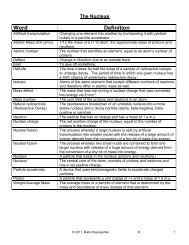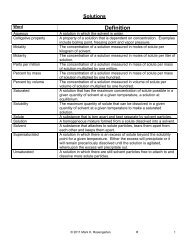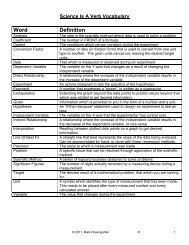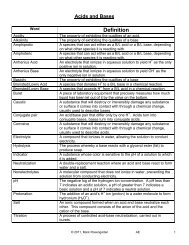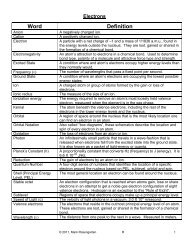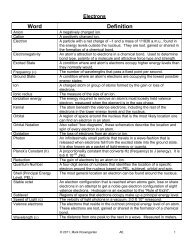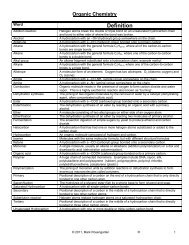Unit 4 - Mark Rosengarten
Unit 4 - Mark Rosengarten
Unit 4 - Mark Rosengarten
Create successful ePaper yourself
Turn your PDF publications into a flip-book with our unique Google optimized e-Paper software.
3) Half-Life (HW: p. 24, 25)<br />
Essential Question: How exactly do we know how old archeological remains are? How can radioactivity save your<br />
life?<br />
Radioactive Decay is a RANDOM process. It is not possible to predict when a particular nucleus will decay, but we<br />
can make fairly accurate predictions regarding how many nuclei in a large sample will decay in a given period of time.<br />
Definition of Half-Life:<br />
The half-life of a radioactive isotope is defined as the period of time that must go by for half of the nuclei in the sample<br />
to undergo decay. During one half-life period:<br />
- Half of the radioactive nuclei in the sample decay into new, more stable nuclei<br />
If a sample contains 1000 nuclei of a radioactive isotope now, 500 will undergo decay over the course of one half-life.<br />
- Half the mass of the radioactive isotope is converted into a new, more stable isotope<br />
If a sample contains 4.0 grams of a radioactive isotope now, after one half-life, 2.0 grams will remain undecayed, the<br />
other 2.0 grams will be made up of a new, more stable isotope.<br />
- A Geiger-Müeller counter’s count-per-time period will be half of what it started at<br />
If a Geiger-Müeller counter is showing 400 counts per minute now, after one half-life, the counter will show 200 counts<br />
per minute.<br />
After one half-life, half (50%) of the original amount of the sample will have undergone radioactive decay.<br />
After a second half-life, one quarter (25%) of the original sample will remain undecayed.<br />
After a third half-life, one eighth (12.5%) of the original sample will remain undecayed.<br />
NOTE: The actual half-life time is constant. If the half-life is 10 days, then 2 half-lives would take 20 days, 3<br />
half-lives take 30 days, 4 half-lives take 40 days and so on.<br />
The half-life of many radioactive isotopes can be found on Reference Table N.<br />
SOLVING HALF – LIFE PROBLEMS<br />
1) You know how much of the isotope you have now, you want to find out how much will be left after a certain<br />
amount of time (going into the future).<br />
Step 1: Determine how many half-lives have gone by. Take how much time has gone by and divide it by the duration<br />
of the half-life.<br />
Step 2: Cut the amount (mass, percent, fraction, number of nuclei) in half as many times as there are half-lives.<br />
EXAMPLES:<br />
The half-life of Rn-222 (a carcinogenic house pollutant) is 3.8 days. If today your basement contains 20.0<br />
grams of Rn-222, how much will remain after 19 days assuming no more leaks in?<br />
# half-lives = time elapsed/half-life time = 19 days/3.8 days = 5 half-lives have gone by.<br />
So, cut the starting amount (20.0 grams) in half 5 times!<br />
20.0 10.0 5.0 2.5 1.25 0.625 grams is the final amount left!<br />
© 2011, <strong>Mark</strong> <strong>Rosengarten</strong> AE 10




